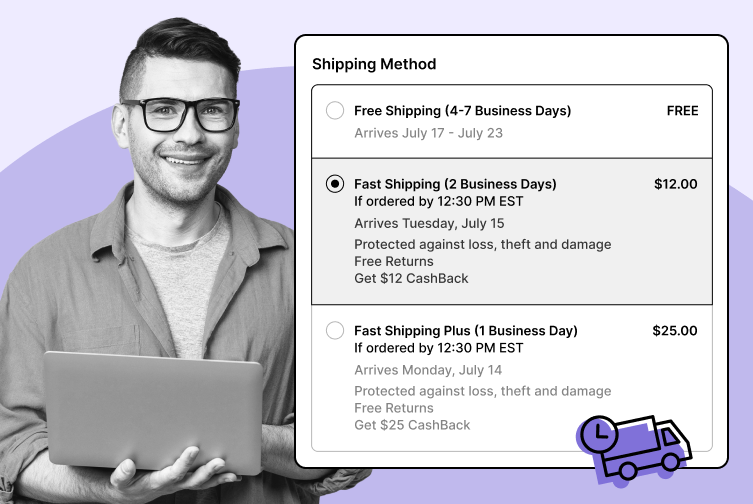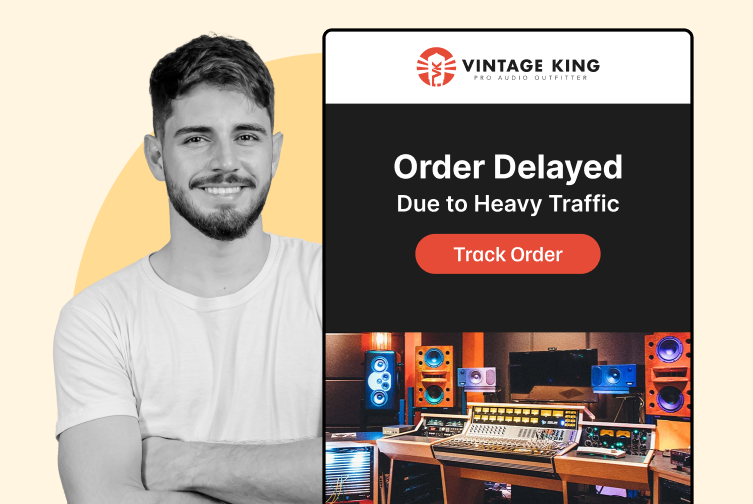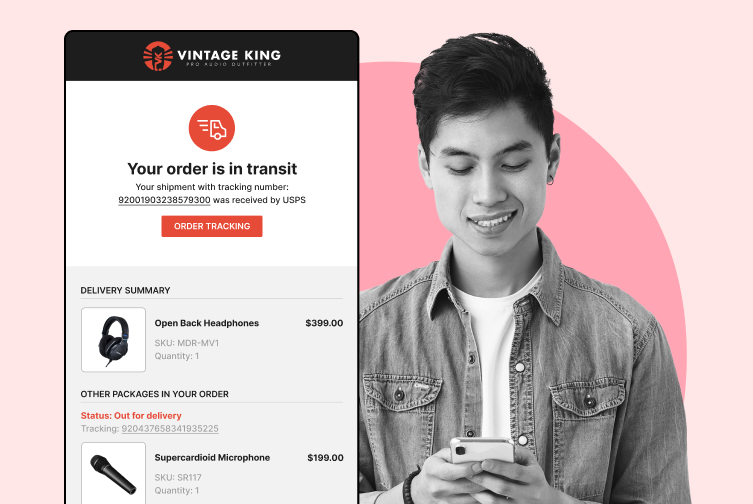
How Shipping Impacts Customer Satisfaction and Brand Loyalty
Explore how shipping affects customer satisfaction and loyalty. Understand the key factors that influence their experience. Read the article to learn more.
Shipping, Tracking & Notifications
Boost customer experience and reduce support tickets
Realtime order and shipment tracking
Proactive order and shipping notifications
AI-Enhanced Discounted Labels
Predictive pre-purchase estimated delivery dates
Self-Serivce branded order tracking
Effortless experience delivered
Identify and Resolve Order Issues
Realtime order and shipment tracking
Make returns profitable and delight customers
Flexibility to define any return destinations & conditions
Simplify returns for your customers and team
Incentivize exchanges over returns
Returns management made easy for your team
Returns management made easy for your team
Easy claims and smart upsells
Understand why your customers are returning
In-Store & Curbside Pickup
Unify the online and the in-store experience
Hassle-free pickup experience for customers
In-Store dashboard to keep operations streamlined
In-Store and Online orders unified
Drive foot-traffic to your stores
Shipping, Tracking & Notifications
Boost customer experience and reduce support tickets
Realtime order and shipment tracking
Proactive order and shipping notifications
AI-Enhanced Discounted Labels
Predictive pre-purchase estimated delivery dates
Self-Serivce branded order tracking
Effortless experience delivered
Identify and Resolve Order Issues
Realtime order and shipment tracking
Make returns profitable and delight customers
Flexibility to define any return destinations & conditions
Simplify returns for your customers and team
Incentivize exchanges over returns
Returns management made easy for your team
Returns management made easy for your team
Understand why your customers are returning
In-Store & Curbside Pickup
Unify the online and the in-store experience
Hassle-free pickup experience for customers
In-Store Dashboard to keep operations streamlined
In-Store and Online orders unified
Drive foot-traffic to your stores
Boost customer experience and reduce support tickets
Realtime order and shipment tracking
Proactive order and shipping notifications
AI-Enhanced Discounted Labels
Predictive pre-purchase estimated delivery dates
Self-Serivce branded order tracking
Effortless experience delivered
Make returns profitable and delight customers
Flexibility to define any return destinations & conditions
Simplify returns for your customers and team
Incentivize exchanges over returns
Returns management made easy for your team
Equip your team for precise return checks.
Easy claims and smart upsells
Understand why your customers are returning
Unify the online and the in-store experience
Hassle-free pickup experience for customers
In-Store Dashboard to keep operations streamlined
In-Store and Online orders unified
Drive foot-traffic to your stores
Find the answer to all your questions
Take a step by step trip through our functionality to see how we can improve your ecommerce processes.
Explore the most comon questions about WeSupply
Calculate the ROI that WeSupply can bring you
Read actionable articles on how to optimize your post-purchase experience and decrease support tickets
Get inspired by stories of how our customers implemented an effortless post-purchase experience
Wondering if WeSupply is a good fit for you? Read through our use cases to see how we can help you increase conversion & improve CX!
A Deep Dive into Top Companies' Order Tracking & Returns Strategy
Find the answer to all your questions
Explore the most comon questions about WeSupply
Calculate the ROI that WeSupply can bring you
Request a no strings attached review of your current shopping experience and missed conversion opportunities
Take a step by step trip through our functionality to see how we can improve your ecommerce processes.
Read actionable articles on how to optimize your post-purchase experience and decrease support tickets
Get inspired by stories of how our customers implemented an effortless post-purchase experience
A Deep Dive into Top Companies' Order Tracking & Returns Strategy
Wondering if WeSupply is a good fit for you? Read through our use cases to see how we can help you increase conversion & improve CX!

In the fast-paced world of ecommerce, shipping is no longer just a backend function. It’s a key part of the customer experience and a direct driver of business profitability. With rising customer expectations and increased pressure on margins, online retailers must look at every aspect of their shipping operations to reduce return rates and protect their bottom line.
So how do you strike the perfect balance between customer satisfaction and operational efficiency? The answer lies in shipping optimization. From smarter packaging to leveraging technology and rethinking reverse logistics, this guide walks you through actionable strategies to reduce returns and increase your margins.
Returns are a costly reality of ecommerce, with industry data estimating that nearly 30% of online purchases are sent back. These returns eat into profits, not just through refunded sales, but via return shipping costs, restocking labor, and potential resale markdowns. Processing returns involves receiving the returned items, inspecting their condition, and determining whether they can be restocked, refurbished, or need to be disposed of.
Common reasons for returns include damaged products, inaccurate descriptions, wrong sizing, or items not meeting customer expectations. Addressing these root causes can significantly reduce return rates. But it all starts with understanding the “why” behind each return. Gathering customer feedback through surveys or questionnaires is essential for identifying the underlying reasons for returns and improving the overall customer experience.
Retailers who analyze return data consistently spot patterns, like one SKU accounting for a disproportionate share of returns, or specific categories more prone to damage in transit. Analyzing return data helps uncover product or process issues, enabling businesses to make targeted improvements and reduce future returns. These insights are the first step toward shipping smarter.
One of the easiest ways to reduce returns is by setting accurate expectations. High-quality product descriptions and visuals help ensure customers know exactly what they’re buying.
Use high-resolution images that show products from multiple angles. Consider 360-degree product viewers, especially for categories like fashion, electronics, or home goods. Include zoom capabilities so customers can inspect texture and details. For apparel, model sizing information and body measurements help buyers find the right fit.
Detailed written descriptions should include exact dimensions, material specifications, care instructions, and usage scenarios. Augment these listings with user-generated content photos and videos from real customers which adds authenticity and shows the product in real-life use.
Some ecommerce businesses are also adopting AR and AI-driven sizing tools that let customers virtually try on products or get smart size recommendations. This tech dramatically reduces “wrong fit” returns.
Damage during transit is another major return trigger, and one that can be easily avoided. Start with a robust quality control process before an item even leaves your facility. A quick inspection for visible defects, functionality, and completeness can save time and money down the line.
Packaging plays a double role here. It protects products and affects your shipping costs. Oversized boxes not only increase the risk of damage from movement inside the package but also incur higher dimensional weight charges.
Use right-sized boxes or poly mailers for non-fragile items. Include protective dunnage like air pillows or recyclable paper for fragile goods. Custom packaging can also help high-volume SKUs travel safely without overuse of materials.
Thoughtful packaging and thorough quality control not only reduce the likelihood of returns but also contribute to a positive customer experience, playing a key role in enhancing customer satisfaction throughout the returns process.
In addition to physical protection, consider brand presentation. Beautiful, eco-conscious packaging that balances protection and experience can make unboxing memorable and reduce buyer’s remorse.
Clear communication goes a long way in reducing dissatisfaction. When customers know what to expect, they’re less likely to be disappointed.
Provide transparent shipping timelines and costs upfront no one likes hidden fees or vague delivery windows. Use real-time tracking and automated notifications via email or SMS to keep customers informed every step of the way.
Just as important is your return policy. Make it easy to find, easy to understand, and ideally, easy to execute. Clear instructions and streamlined procedures in your return process enhance customer satisfaction by making returns hassle-free and transparent. Creating a seamless and efficient return process not only improves operational efficiency but also builds customer trust. Customers are more likely to buy if they feel supported in case something goes wrong. The smoother the process, the more likely they are to return (in a good way).
Manual return processes are not only inefficient but also costly and error-prone. That’s where returns management software comes in. With a digital system in place, you can automate the initiation, tracking, and resolution of returns.
Self-service portals allow customers to request returns, print labels, and track the status without needing to contact support. This reduces strain on your service team and improves the customer experience.
Returns platforms can also integrate with your order management system (OMS) and warehouse management system (WMS), streamlining logistics and restocking workflows. Automation of return processing not only reduces delays and errors but also supports improved inventory management by efficiently reintegrating returned items into stock.
Leveraging data from returns management software enables data driven decision making for continuous process improvement.
Return data is a goldmine of insight. Tracking reasons for returns by product, category, and customer type can reveal issues you didn’t know you had. Maybe your sizing chart is off, or a popular item has a defect in a recent batch.
These insights can be used to update product descriptions, discontinue problematic SKUs, or adjust vendor relationships. The key is to act on the data, not just collect it.
You can also track performance over time are returns going down after implementing new images or size guides? Are certain fulfillment centers seeing higher damage rates? By leveraging data analytics, you can gain real-time insights to optimize returns management and make informed decisions. Analyzing return data also helps forecast and mitigate future returns, leading to better product design and reduced costs. These data-driven improvements contribute to overall supply chain efficiency. These answers lie in your return metrics.
Reverse logistics is the hidden engine behind a successful returns process. Efficiently handling returns, restocks, and refunds helps recapture value and minimize operational drag. Well-designed reverse logistics processes are essential for compliance, improving efficiency, and reducing costs.
Some products may not be worth shipping back you can offer keep-it policies for low-cost or bulky items. Others can be refurbished and resold at a discount.
Working with a 3PL that specializes in reverse logistics can streamline this process further. Partnering with specialized providers supports efficient and effective reverse logistics by leveraging automation, real-time tracking, and expertise. Outsourcing the entire process to third-party providers can improve efficiency and customer satisfaction. Look for partners with fast processing times, automated restocking, and customer-friendly return shipping options.
Shipping is a huge line item, but it’s also negotiable. Whether you’re shipping hundreds or thousands of packages, volume can be leveraged for better rates. Don’t just focus on base rates negotiate surcharges, fuel fees, insurance, and dimensional pricing as well. During contract negotiations, it’s important to establish clear performance metrics and service quality expectations to ensure the carrier meets your reverse logistics goals. Focusing on cost efficiency in these negotiations can help maximize value and reduce expenses.
Get quotes from multiple carriers or consider working with shipping aggregators that pool volume for discounts. Some platforms allow you to compare rates in real time and choose the most cost-effective option per shipment.
Also consider prepaid shipping options if you ship consistent volumes, or hybrid models like UPS SurePost or FedEx SmartPost, which can save 20–30% on last-mile delivery.
Packaging doesn’t just affect returns it’s a huge driver of shipping costs. Right-sizing your boxes minimizes dimensional weight charges. Swapping to lighter packaging materials, like poly mailers or recycled fillers, can also lower total costs.
Some carriers offer free packaging materials that can reduce supply costs while keeping branding consistent. Eco-friendly materials are another way to appeal to sustainability-minded consumers while reducing landfill waste.
Review your packaging strategy regularly, especially if you’ve added new product lines. What worked for one SKU might not work for another. Optimizing packaging can also help manage warehouse space more efficiently and reduce storage costs associated with returned or unsold inventory.
DMPs are game-changers for logistics teams. These platforms help you optimize delivery routes, assign drivers, and track orders in real time. The result? Lower fuel use, fewer delays, and better on-time delivery rates.
These systems often integrate with your ecommerce platform, providing customers with tracking links and delivery updates automatically. Internally, they help forecast demand, identify choke points, and monitor performance KPIs.
Efficiency here means fewer failed deliveries and fewer frustrated customers—which, yes, means fewer returns.
Consolidation isn’t just for large freight. Even in parcel shipping, grouping items going to the same destination can lower per-unit shipping costs. This is especially true for B2B or subscription-based models.
At the inventory level, shipping from the closest fulfillment center minimizes travel distance and lowers costs. Having the right inventory in the right place is key to faster, cheaper fulfillment.
Inventory forecasting tools can help avoid unnecessary split shipments, which double your shipping costs and increase the chance of errors or delays.
Your shipping costs are directly impacted by the geography of your warehouses. Locating inventory closer to your customer base reduces shipping zones and transit time.
Using 3PLs or distributed fulfillment centers lets you store goods regionally. For urban areas, micro-fulfillment centers allow for even faster delivery while keeping last-mile costs down.
For growing brands, this decentralization can be a powerful lever for both cost reduction and customer experience improvement.
Offering flexibility in delivery can lower costs and increase customer satisfaction. Options like BOPIS (Buy Online, Pick Up In Store), curbside pickup, and locker pickups eliminate shipping altogether.
For local orders, consider offering your own delivery service or working with local courier networks. Not only can this be cheaper, but it gives you full control over the customer experience.
In areas with dense populations, this is a particularly effective way to reduce carrier fees and improve delivery speed.
Free shipping remains one of the most powerful incentives in ecommerce. But it has to be offered strategically.
One method is to bake shipping costs into product prices. Another is to set a free shipping threshold just above your current average order value to encourage larger purchases.
Limit free shipping or free returns to high-margin items, loyal customers, or promotional periods. Some retailers use restocking fees to offset returns costs and influence customer behavior, especially in industries with high return rates. Managing returns costs is essential for profitability, as efficient reverse logistics help maintain margins. Offering store credit as an alternative to refunds or exchanges can also help maintain customer satisfaction after a product inspection. Additionally, free returns policies can enhance brand loyalty and encourage repeat business. This lets you stay competitive without sacrificing margins.
Centralized return centers are transforming the way online merchants handle returns, offering a more efficient and cost-effective approach to the entire returns process. By consolidating returns processing in a single, dedicated location, businesses can streamline operations, reduce costs, and deliver a better customer experience.
Centralized returns offer significant benefits for both operational efficiency and customer satisfaction. By processing all returns in one location, businesses can standardize their returns management process, leading to faster inspections, repairs, and restocking. This not only reduces processing costs and labor expenses but also improves inventory management by quickly returning products to sellable stock.
Centralized return centers also make it easier to collect and analyze return data, enabling businesses to spot trends, identify recurring issues, and make data-driven decisions to optimize their returns management. This proactive approach can help reduce unnecessary returns, improve the entire returns process, and enhance customer loyalty by ensuring a smooth, hassle-free experience.
Ultimately, a centralized approach to returns gives businesses a competitive edge delivering cost savings, improved customer satisfaction, and more effective inventory management, all of which contribute to long-term success in the ecommerce landscape.
To manage returns efficiently, you need the right people, space, and systems. Warehouses should be set up to handle reverse logistics workflows without disrupting outbound shipping.
Ensure that your staff is trained in inspecting, processing, and restocking returned goods. Labor costs are a significant factor in managing returns efficiently, as handling returned items requires dedicated staff time and resources. Integrate returns into your WMS and track return-related KPIs.
Capacity planning becomes essential during peak seasons. Make sure your infrastructure can scale to handle increased return volumes without delays.
Self-service return options streamline the process for both the business and the customer. Let customers initiate returns, print labels, and track their return status online.
This reduces manual processing time, improves customer experience, and cuts support costs. Platforms that offer branded return portals can also reinforce your brand’s professionalism and transparency.
Shipping and returns optimization isn’t a one-time project. It requires continuous monitoring and refinement.
Track return rates by product, average shipping cost per order, time to delivery, and refund resolution time. Keep an eye on customer satisfaction scores and Net Promoter Score (NPS). Efficient returns management not only improves these metrics but also leads to repeat business by encouraging repeat purchases and building trust. A seamless returns process is key to encouraging repeat business and fostering long-term customer relationships.
Also audit your shipping invoices regularly to catch billing errors and identify renegotiation opportunities. These small improvements compound into big gains over time.
In ecommerce, shipping is no longer just a backend operation, it’s a defining part of the customer experience and a key driver of profitability. To reduce costly returns and protect margins, you need more than fast delivery you need complete post-purchase visibility, intelligent automation, and actionable insights. That’s where WeSupply comes in.
WeSupply equips retailers with a powerful suite of tools designed to streamline shipping, elevate the customer experience, and drive operational efficiency all while reducing return rates and boosting your bottom line.
Here’s how WeSupply contributes to smarter shipping and healthier margins:
Automated Delivery Notifications: Reduce WISMO (“Where Is My Order?”) support tickets with proactive SMS and email alerts at every delivery milestone.
Estimated Delivery Dates at Checkout: Set accurate expectations upfront to reduce cart abandonment and improve customer satisfaction.
Branded Post-Purchase Experience: Turn transactional touchpoints into marketing opportunities with custom tracking and status pages aligned to your brand.
Store and Curbside Pickup Integration: Offer flexible fulfillment options that support modern shopping habits and reduce shipping volume and costs.
Seamless Self-Service Returns: Let customers initiate returns through an easy-to-navigate, branded portal with instant label generation and real-time refund tracking.
Exchange-First Return Flows: Encourage exchanges over refunds to retain revenue and lower refund-related losses.
Return Reason Capture: Collect return feedback to identify product issues, improve listings, and reduce future returns.
“Keep the Item” Rules: Automatically offer keep-it policies for low-cost or bulky returns, minimizing shipping and restocking expenses.
Intelligent Return Rules: Set custom conditions for return eligibility based on product type, return reason, or customer behavior to reduce fraud and abuse.
Return & Shipping Analytics: Monitor carrier performance, delivery accuracy, return trends, and customer satisfaction to fine-tune logistics decisions.
Integrated Return Management: Sync returns with your OMS and WMS for faster restocking, better inventory visibility, and fewer manual errors.
Norton Shopping Guarantee: Build buyer trust with order protection against lost, damaged, or late shipments, reducing hesitation and increasing conversions.
By integrating WeSupply, merchants gain the tools to proactively manage the entire post-purchase journey from estimated delivery at checkout to self-service returns and smart reverse logistics. This creates a seamless, confidence-building experience for customers while helping retailers lower return rates, minimize operational costs, and ultimately grow profit margins. Book a demo today!
Eliminate shipping anxiety
Book a quick call with our experts to see how WeSupply can help you fulfill customer demands and gain long-term trust by clearly addressing shipping insurance.
Shipping optimization isn’t just a logistics upgrade it’s a growth strategy. With WeSupply, you can turn shipping and returns into seamless, branded experiences that reduce costly errors, lower return rates, and increase customer satisfaction.
From estimated delivery dates at checkout and branded tracking pages to real-time notifications and store or curbside pickup options, WeSupply ensures your customers stay informed and in control. Behind the scenes, features like delivery performance analytics, return reason capture, and intelligent return rules help you spot issues early, streamline reverse logistics, and protect your margins. Self-service returns, exchange-first flows, and keep-the-item policies reduce friction while preserving revenue, and integrations with OMS, WMS, and platforms like Magento and BigCommerce ensure operations scale efficiently.
With added trust from the Norton Shopping Guarantee, your post-purchase experience becomes a competitive edge. In today’s ecommerce landscape, shipping smarter with WeSupply means fewer returns, stronger loyalty, and better margins all without sacrificing experience.
Combat inconvenience with proactivity & self service
Book a quick call with our experts to see how WeSupply can help you make returns easy for your customers with a beautiful, self-service solution that makes their experience easier while also providing new ways to lower costs and earn back revenue.
1. How can ecommerce businesses reduce return rates through shipping optimization?
Use right-sized packaging, real-time tracking, clear delivery expectations, and enhanced product descriptions. Accurate, transparent shipping helps prevent returns due to damage, delays, or unmet expectations.
2. What role does packaging play in reducing ecommerce returns?
Properly sized and protective packaging prevents damage in transit, lowers dimensional weight fees, and improves customer satisfaction, significantly reducing return rates and operational costs.
3. How do clearer product descriptions help lower return rates?
Detailed descriptions with high-quality visuals and sizing information reduce confusion and mismatched expectations, leading to fewer returns and better customer satisfaction.
4. How does WeSupply reduce ecommerce return rates?
WeSupply reduces returns by offering accurate delivery dates, real-time tracking, branded post-purchase pages, and return reason capture to identify and fix product or listing issues.
5. Can customers use WeSupply to make self-service returns?
Yes. WeSupply offers a branded self-service returns portal with instant label generation, real-time tracking, and exchange-first flows to retain revenue and enhance convenience.
6. What WeSupply features help ecommerce businesses protect their margins?
WeSupply helps protect margins through smart return rules, exchange-first flows, “keep the item” policies and Norton Shopping Guarantee integration for trusted post-purchase experiences.
7. Does WeSupply have an Official Shopify App?
Yes. WeSupply has an Official Shopify App. You can download it and start integrating with your Shopify Store.
8. Does WeSupply have an official Magento extension?
Yes, WeSupply has an official extension for Magento. The WeSupply x Magento integration allows for automating order tracking experiences, reducing customer inquiries, automating shipping email and SMS notifications, and providing a fully branded order tracking experience
9. Does WeSupply have an official BigCommerce App?
Yes, WeSupply has an official BigCommerce App. You can integrate WeSupply with your BigCommerce store to improve your post-purchase customer experience.
Learn How To Create Successful Post Purchase Email Campaigns
Build an effective post-purchase email flow that helps you increase customer satisfaction and drive revenue growth!

Explore how shipping affects customer satisfaction and loyalty. Understand the key factors that influence their experience. Read the article to learn more.

Learn how dynamic shipping rates at checkout can enhance pricing strategies and improve customer satisfaction. Discover practical tips in our article.

Effective strategies for communicating shipping delays to keep customers informed and satisfied. Enhance your customer service approach!

Discover effective strategies to manage split shipments, reduce delays, and enhance customer satisfaction. Practical solutions!

Discover how enhanced estimated delivery dates can boost your e-commerce sales. Learn practical strategies to improve customer satisfaction today!
Master unified tracking for split or multi shipment orders with our comprehensive guide. Streamline your process and improve efficiency—read more now!

Learn effective strategies for handling shipment exceptions and improving customer communication. Read the article for practical tips and insights.

Discover how effective shipping insurance integration can enhance your business efficiency and protect your assets. Read the article for practical insights.

Discover effective strategies to manage your shipments with ease. Streamline your process and enhance your shipping efficiency!